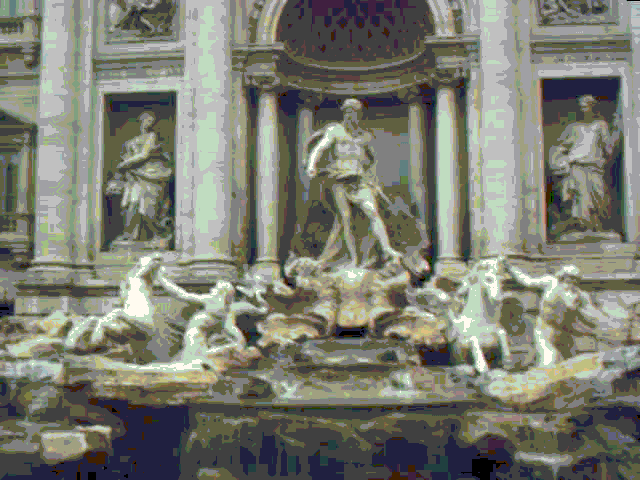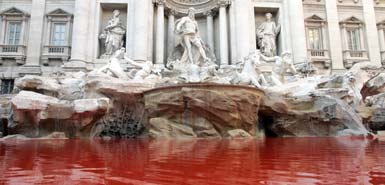
==================================

by Guy Shaked
Keywords: Fontana di Trevi, Gianlorenzo Bernini, Love, Nicola Salvi, Phaedrus, Plato, Shaked, Soul, Trevi fountain
The Trevi fountain is the largest and most famous of all of the fountains of Rome . There is a belief (superstition) that anyone throwing a coin over his shoulder while standing with his back to the fountain - shall see Rome again. The Trevi is known also as the place Anita Ekberg bathed in Fellini's "La Dolce Vita" and was rescued out of the fountain by Marcello Mastroianni.
The fountain was built from 1732 to 1762, according to a design by Nicola Salvi, who won the competition for a design of a new fountain, by Clement XII. The Trevi fountain is the work of nine sculptors and its history begins in 19 BC, with the completion of the Aqua Virgo aqueduct by Marcus Vipsanius Agrippa, during the rule of Augustus. The name of the fountain derives most likely from the word "trivium" referring to the three roads that converged there [1]. A fountain was erected in the piazza in the time of Nicholas V, later to be demolished and replaced by another unfinished project for a new fountain by Bernini [2], which was later again demolished to make way for Salvi's fountain.
Bernini's fountains and statues profoundly influenced Salvi [3]. The Treviís statues can be seen as a sort of Berninian Bachanalia - containing his motives in seemingly disorder, from Berniniís many pieces: branches and leaves (Daphne), travertine rocks (Four Rivers), the horse in water (Four Rivers), the Triton sounding the horn (Glaucus), the shell (the Bees Fountain, Glaucus).
Salvi, in the Trevi founatin, was also influenced from Bernini, in his integration of Sculpture and Architecture in the fountain [4] (perhaps Pietro da Cortona's project for the Trevi also influenced him in that) [5]. In the central group, Oceanus commands the Tritons taming the two horses in the currents, is a display of control over water. The figures of the Tritons are ambivalent as the left hand Triton instead of blowing a conch shell to order the waters to calm down orders the horse frightened by the water surging to calm down, while the other Triton does blow a conch shell but it seems more for announcing the arrival of his master than to quite the flowing waters (for the horse he is holding is rather calm).
The figures on the two sides of Oceanus are more relaxed, representing allegories showing the power of waters of the fountain. They are Health, holding a libation cup from which a snake drinks, and Fertility which behind her an overturned urn spills water, which makes plants, grow.
Two bass reliefs above, represent the beginnings of the aqueduct which opens out at the mouth of the Trevi. One depicts the story of the maiden who pointed to Roman soldiers the place of the springs which feed it, the other represent Agrippa supervising its construction.

Yet, the central image of the Trevi fountain has a allegorical layer of meaning, revealed here for the first time : as the soul in love. Based on the allegory of the soul in love as described in Plato's Phaedrus:
"As I said at the beginning of this tale, I divided each soul into three-two horses and a charioteer; and one of the horses was good and the other bad: the division may remain, but I have not yet explained in what the goodness or badness of either consists, and to that I will proceed. The right-hand horse is upright and cleanly made; he has a lofty neck and an aquiline nose; his colour is white, and his eyes dark; he is a lover of honour and modesty and temperance, and the follower of true glory; he needs no touch of the whip, but is guided by word and admonition only. The other is a crooked lumbering animal, put together anyhow; he has a short thick neck; he is flat-faced and of a dark colour, with grey eyes and blood-red complexion; the mate of insolence and pride, shag-eared and deaf, hardly yielding to whip and spur. Now when the charioteer beholds the vision of love, and has his whole soul warmed through sense, and is full of the prickings and ticklings of desire, the obedient steed, then as always under the government of shame, refrains from leaping on the beloved; but the other, heedless of the pricks and of the blows of the whip, plunges and runs away, giving all manner of trouble to his companion and the charioteer, whom he forces to approach the beloved and to remember the joys of love."
Indeed this fits the central part of the fountain perfectly. As the central figure, representing the soul in love, rides on a chariot pulled by two winged horses: one calm and one wild. The older looking, bearded Triton (representing perhaps Socrates) is leading the calmer winged horse (representing calm rational love), while the younger looking Triton (representing perhaps Phaedrus) is trying to calm the rearing winged horse (representing wild irrational love) [6].
Read the improved and enhanced article in Masters of Italian Sculpture
----------------------------------------------
[1] Felini, M., Tratado nuevo de las cosas meravillosas de la alma cividad de Roma (Rome, 1610), p. 86
[2] Pinto, J. A., The Trevi Fountain, New Haven, Yale University Press, 1986, pp. 28-31, 41-46
[3] Pinto, J. A., Cit., pp. 51-52, 232
[4] Bernini was considered as the first to have united architecture, sculpture and painting into a beautiful whole (according to his biographers, Baldinucci, F., Cit., p. 74, and Bernino, D., Cit., pp. 32-33) Thus creating what Bernini termed "a beautiful whole". And see Lavin's discussion of this feature in Bernini's art in Lavin, I., Bernini and the Unity of the Visual Arts, New-York, Oxford University Press, 1980, pp.6-15
[5] Pinto, J. A., Cit., p. 55
[6] See Pinto's description: Pinto, J. A., Cit., p. 139. This is based on Salvi's own description (ibid. p. 284).
Review:
| REVIEWER | COMMENT |
| van Hoorn & Smits- Holland (members.lycos.nl/eracommunity) | interesting piece |
Dear visitor, please take a short moment to sign my guest book!
----------------------------------------------------------------

© 2003-2004 Emails are
gladly received: shakedtg@hotmail.com
Hidden symbolism in Bernini's David
The nudity of Michelangelo's David
The horns as the sign of the betrayed in Michelangelo's Moses
Canova's Eve as depicting a conversion to Christianity
Other articles by G. Shaked:
ART
BIBLICAL STUDIES
BIOLOGY
CINEMA
LITERATURE
MUSIC
PHILOSOPHY
PHYSICS
(ACOUSTICS)